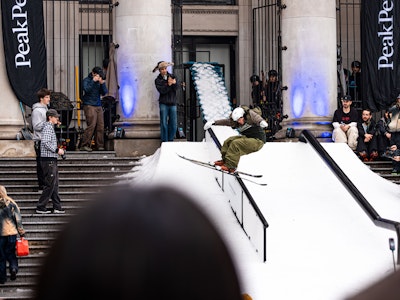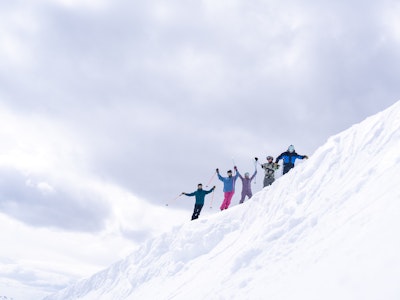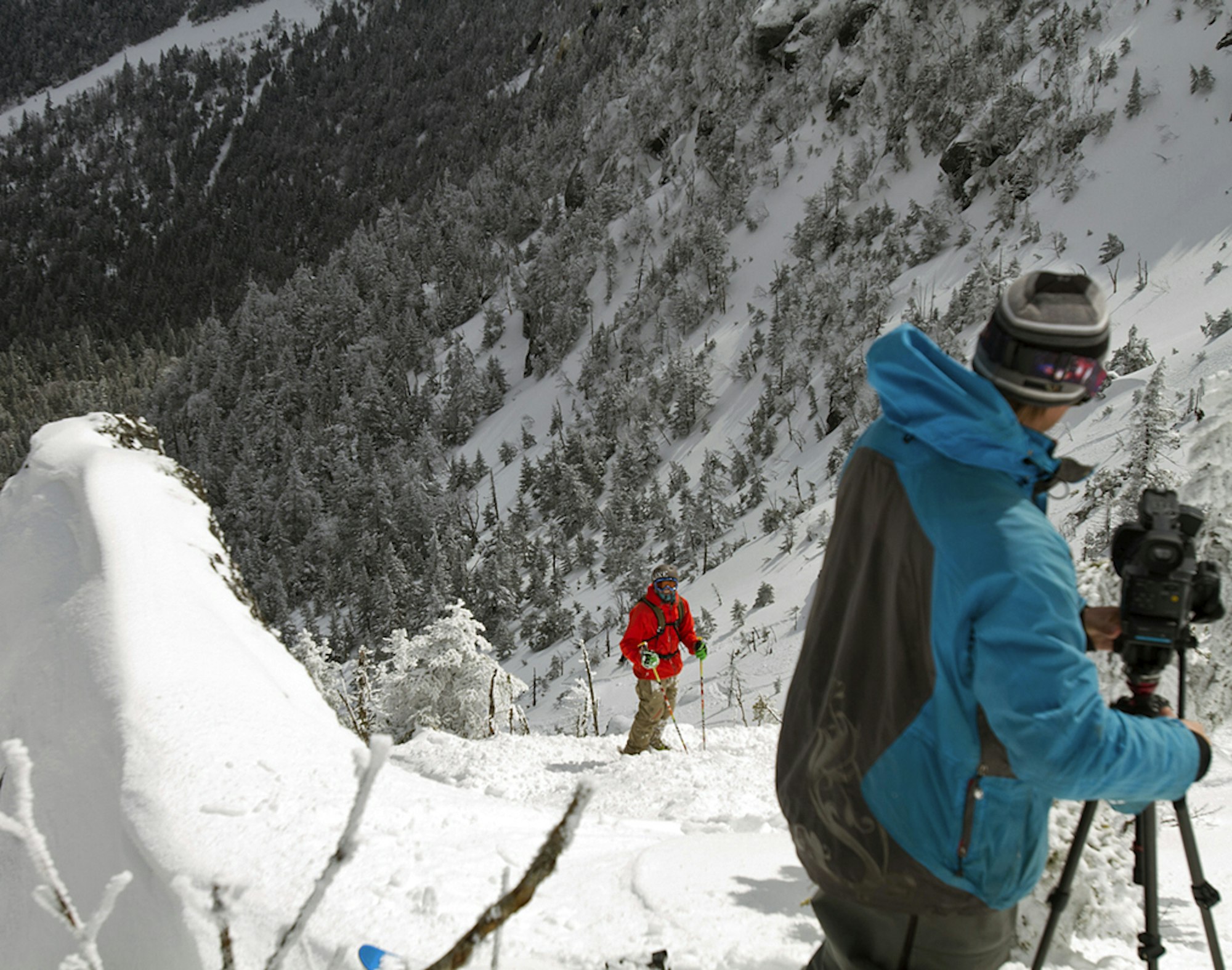Meathead Films have been spreading the east coast freeskiing stoke for over thirteen years, releasing a yearly film showcasing the best, and many times, the worst, skiing that the east has to offer. Eastern skiing holds a special place in many a Freeskier staffer’s heart, being that many of us grew up back there, and a few of us even attended the same school as Meathead founders Chris “Rooster” James and Geoff McDonald, the University of Vermont. Recently, we sat down with James and McDonald for a quick phone chat, discussing the future of the Meathead Films brand, skiing the east, and why UVM is quite simply, the best.
On the phone:
What’re you guys up to right now?
Chris James:
Just down in Burlington at Outdoor Gear Exchange getting ready for a screening of Working for the Weekend.
Take us through the decision not to produce a feature film this year.
CJ: We’ve been planning it for a couple of years actually. The year we produced No Matter What was going to actually be our first year totally web based, and then towards the middle of the season we decided to pull the trigger to do another feature film, because we were able to bring together an overseas trip to Switzerland. That segment turned into three segments in the film and pretty much allowed us to make a feature length film and do another movie tour.
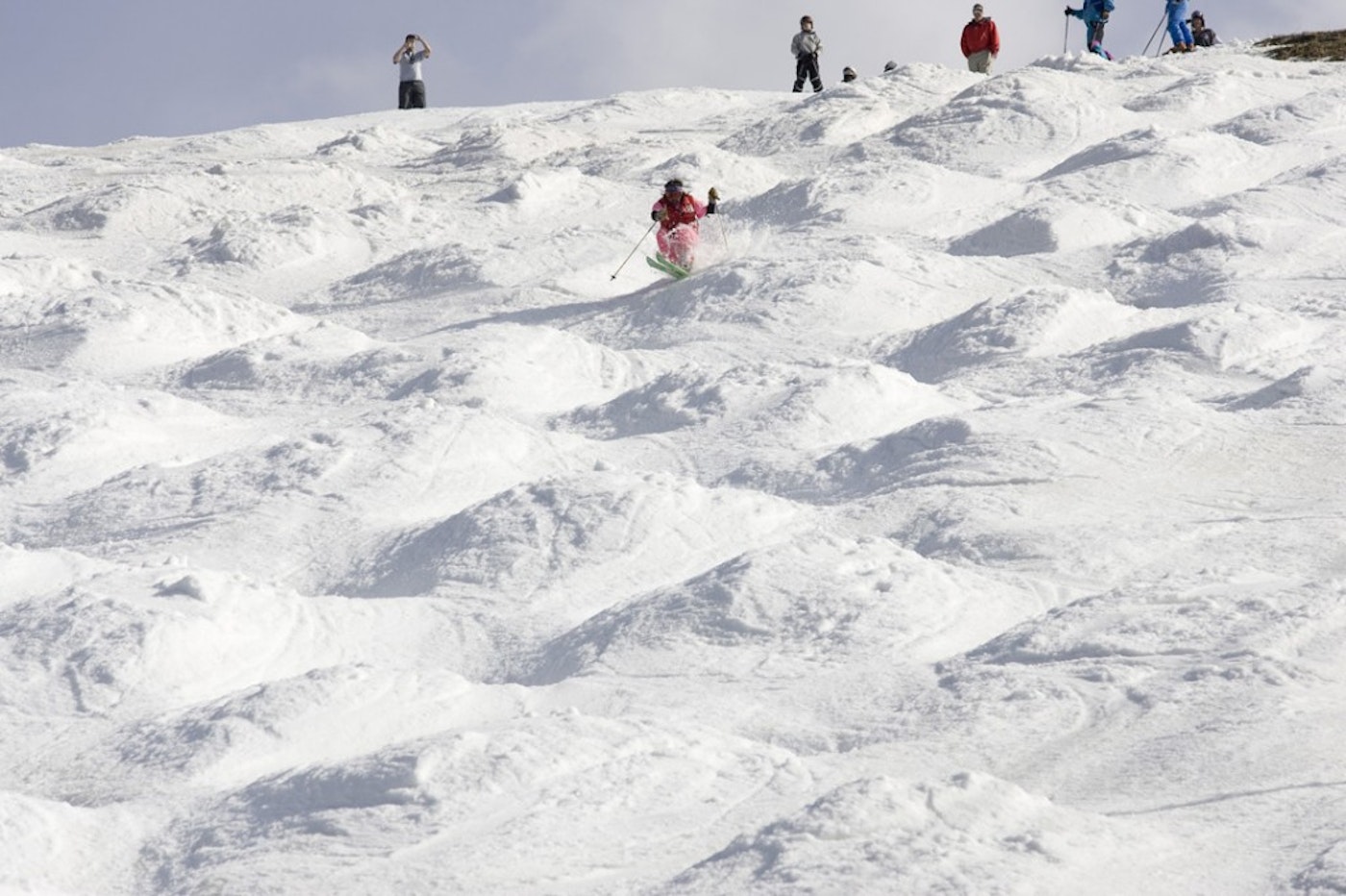
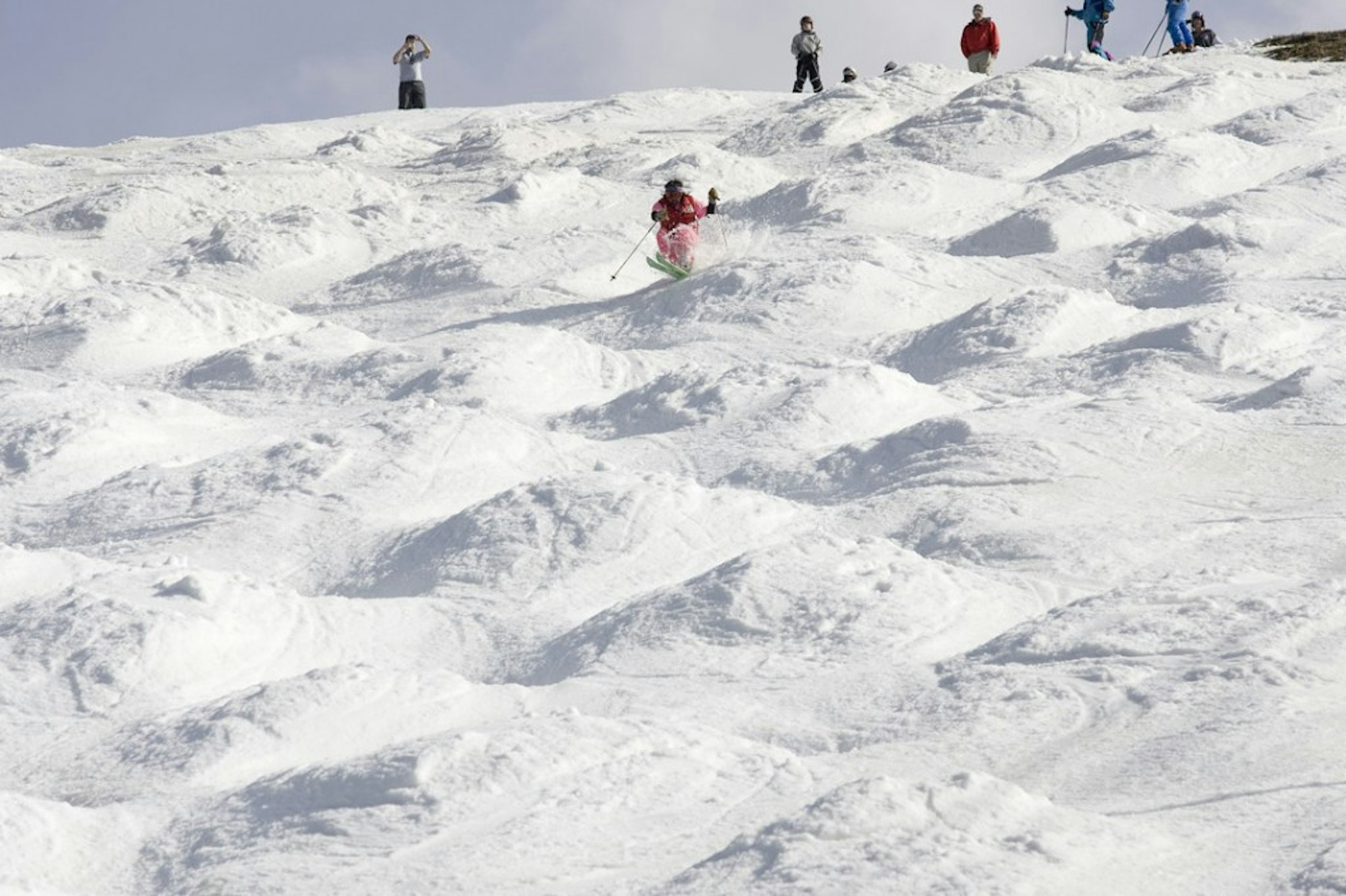
“The Hammer” blasting Killington moguls. Photo by C. Nelson James.
We’ve been talking about it for a while, we just hit a plateau and felt like we hit the ceiling with how big we could take Meatheads as far as sponsorship, movie tour stops and DVD and iTunes distribution. At the same time the Ski The East brand was growing a bunch, gaining a lot of momentum with that, and we were talking about ways to grow and saw a lot of potential in Ski The East clothing, merchandise and the website, as well as the social media reach. We also produce a competitive event here called the Ski The East Freeride Tour (STEFT), so we had all of these other irons in the fire and have been doing Meatheads for 12 or 13 years now. We’ve built great brand recognition with that, so the idea was to cut out the overhead of the three month movie tour, the whole DVD replication process, and being locked in to film sponsorships, and transition to the whole digital age, because that’s becoming a very standard model now in the film industry.
Do you think that feature length films will ever go away in favor of web based projects?
Geoff McDonald:
No, I don’t think so. I think there will always be room for feature length ski movies, but I think that even the companies that are continuing to make DVD and blu ray, doing movie tours, they’re obviously realizing that they need to put a lot more content online. Whether that be documentary type stuff or whether that be actual segments from the movie that come out right after the movie is released. Nobody used to do that because you wanted to keep your DVD as valuable as possible. No one put the primo content online, but now it’s pretty commonplace. I think that there will definitely be a place for feature length ski movies always, but I just think to survive, all companies need to keep the hype alive online and put stuff out on a year-round basis.
Chris:
In general I’d say there’s obviously a lot more creative license with web projects just because people expect to see anything and everything. You’re not tied down to this crazy production schedule having to get the absolute most banger shots every day that you’re out there, grinding away all season to produce the best feature length film that you can. For us it definitely took a lot of pressure off of that cycle that we were in, but we still obviously try to produce the best quality content that we can.
Geoff:
Or just to tell a better story that you might not put into a ski movie because you’re worried about how different segments will transition and the total length of the movie and those type of restrictions. For us, we have two different series going that are pretty different and might not fit together well in one movie, because it would be too long or just too much storytelling. But it’s great online because we can release them once a week, it’s a digestible format and we can kind of tell the story that we want to tell and maybe show footage that we wouldn’t normally put in a movie.
Tell us about the inspirations for both Neo and Working for the Weekend.
Geoff:
The idea behind Neo is the continuation of the Meathead brand; a mix of backcountry, and urban and park skiing. With the title, Neo means new, so we have a new format, we had mostly a new crew last year, the idea was continuing the Meathead, East Coast stoke. The only thing we don’t have in there is bump skiing, because I had a baby in May and it sort of interrupted our bump skiing.
Working for the Weekend is totally Ben Leoni’s brainchild. He thought that up two summers ago and worked on organizing all that and getting the filmers together. He wanted to showcase some of the higher alpine descents, especially in the White Mountains of New Hampshire, something we filmed a few times but really wanted to focus on it for a whole season.
Chris:
Secretly we’ve always wanted a White Mountain, big mountain project, so Ben took the reigns of that and definitely over-delivered in the first year. He was shooting mostly with Jim Surette who lives right in the Mount Washington Valley and is a really accomplished filmmaker. He did the Tuckerman segment with Warren Miller, Chris Davenport, and Hugo Harrison, and when Ben said he had Jim Surette lined up we felt really good about that, and we’re really happy he came on board to work with Ben.
Switching gears, seeing promotions like Henrik Harlaut and Phil Casabon’s B&E Show, where they tour small ski areas in New England and the Midwest, and Andy Parry’s Tell A Friend Tour, what do you guys have to say about bringing that exposure to these smaller, more localized scenes?
Geoff:
I think people are realizing that you can’t just live online, as an online enigma putting out edits. You’ve got to go out and meet people, shake hands, and make real connections with people as well. I think that’s what Andy’s doing with the Tell A Friend Tour, and we’re still doing, as much as we can with different events, like STEFT, or [appearing at the] Boston Expo in the fall, that stuff is super important. We don’t want to just be a brand, we want to be able to show people the stuff that we make, whether that be the videos or whether that be the clothing. That’s something we did with the movie tour for ten years and now we’re just trying to fill that in with different types of events where we can go out there, meet our fans and keep the East Coast stoke going.
Chris:
One of the things that we have an advantage with by just focusing exclusively on the East Coast is that there are so many small resorts, so many resorts that are super close to each other. That’s where shit started was at these little mom and pop rope tows in somebody’s backyard, that’s how the ski scene began and now you see it in a lot of the industry. The best locations are the mega resorts and insane heli trips; boat trips to Antarctica, that shit’s amazing and super inspiring, not very relatable but amazing to see. But when you have guys like Andy Parry who are just going out, doing the down home Tell A Friend Tour, it’s just super authentic, super relatable, and really attainable. That’s the root of skiing in North America and the World, it’s awesome to see them and be a part of it. I don’t think that aspect of the ski industry is ever going to die, because it’s just engrained in everything we do.
Geoff:
And for Henrik and Phil and those guys, if they can go out and spend a month or two on the road and ski with, I don’t know how many hundred of kids they skied with, but those kids will be fans for the rest of their lives. They created an experience, they have a super diehard fan base, but being able to have the face to face interaction is how you’re going to build lifelong fans and customers.
New England and the eastern United States often get a bad rap when compared to what the west has to offer. How do you guys struggle with that concept, and more importantly, how difficult is it to represent the East Coast in newer, more exciting ways each year?
Chris:
We embrace the struggle. Otherwise we wouldn’t make it anywhere, that’s definitely a big piece of our storytelling, you know? Everybody knows it, the East Coast sucks, a lot, but there’s a few days and specific zones that, if you know where to go and are willing to put in the extra effort, you can get super rewarded. That’s what we always try to highlight and showcase but by all means we don’t try to sugar coat it; we show when it’s icy, and rainy, and shitty, and it is what it is. This is where we grew up, this is the region that we know best, and where we built our lives and company, and we’re honored to be able to represent it in the way that we do.
Photo: Andrew Whiteford in the Jay Peak, VT backcountry. Photo by C. Nelson James.
Geoff:
I think the East Coast as a region has a vibe all of its own; out west people don’t say, “I’m a west coast skier,” they’re from Colorado or California or something like that, whereas on the east you’re an East Coast skier, I think that’s something that makes the region complete, everyone just sort of has that togetherness.
How is the East Coast able to churn out really incredible skiers year in and year out, despite the limited terrain?
Geoff:
Because they have to put up with those kind of conditions, they learn to ski on ice at a young age. And with all of the trees and thick bushes we’ve got out here they learn to make quick decisions and can ski on a wide variety of surfaces. But also, on the freeskiing end, kids tend to focus, when there aren’t big mountains, they’ll focus on hitting jumps or just going out and hitting rails. I remember when we first started filming with Will Wesson, he and LJ [Strenio] would just go out to the ice rink every single day around Burlington, build a rail and hit it for five or six hours. When all you have are small hills you get really good at specific things. I think that’s really been big for urban skiing. I think a lot of the best, if not the best, urban skiers out there are from the East Coast these days.
Chris:
When life gives you turds, you just make a turd smoothie, you know? I think a lot of it too, besides just the conditions that East Coasters grow up on, is that you’ve got to have honed in skills, otherwise you’re going to be eating shit on a sheet of ice, sliding into the tree line. I think another huge part of it is just the mentality of growing up and skiing out here, learning to ski out here, it’s just not taking anything for granted. You get three inches of snow, people are calling a powder day; it’s never icy it’s frozen granular, there’s just a certain optimism out here where people are really good at rolling with whatever is dished out.
In recent years we’ve seen Meathead veterans graduate to bigger film companies out west, whether it be with Level 1, TGR, or Stept Productions. What do you attribute that success to?
Geoff:
I hope that we’ve helped them along the way and been able to showcase their skiing when they were starting out. Some of those guys we still do film with. That’s definitely part of our deal is being able to deal with skiers leaving for different reasons. Whether it’s getting a real job or moving out west and filming with somebody else, but every film company has to deal with that. Sometimes people come back, but not always, so every year we’re dealing with a third of our crew being new guys and rookies. We’re always on the lookout for good talent. I hope that other ski filmmakers look to our movies for up and comers from the east.
“…it’s a testament for their love for the East Coast and the connection we made with them when we were shooting with them back in the day…” – Chris James
Chris:
I feel like we’re kind of the talent scouts out here. We usually go through a pretty quick cycle of talented athletes because they like to think they get recognized through our work. When they are going to make that move they’ve got a resumé, they’re ready to step it up with sponsorship and move on to shoot with film companies out west. It’s been amazing. The whole Stept crew, basically every one of them out there is an East Coaster, and now they’re just holding it down in Colorado. It’s awesome to see with the other guys like LJ, and Will. It’s tough to see those guys leave but it’s great seeing them still willing to come back and shoot with us. It’s a testament for their love for the East Coast and the connection we made with them when we were shooting with them back in the day.
Geoff:
They’re pretty psyched now too. For instance, Will and LJ, are on our STE team, so we’re not really competing against the other films anymore. We can shoot footage that they can use in their movies, like the Level 1 movie, and we can use that footage for our online projects. It’s a win-win for them, if they can come hit the great urban locations out here but still be able to get good footage for their part [in other films].
Chris:
We’d like to think they get a little nostalgic after they’ve been away for awhile. They come back for Christmas or to visit family and they get hyped on where it all started from, so we try to scoop them up and take advantage when they’re back.
Geoff:
LJ gets nostalgic, Will’s a robot.
Are there any up and coming East Coasters that we should keep our eyes peeled for?
Chris:
I don’t know, like Bode Miller, Hugo Harrison, Chris Davenport, dudes like that. [laughs]
Geoff:
We’ve got some good guys on our team that are definitely up and comers.
Chris:
Canadians.
Geoff:
Yeah, Vincent Prevost and Martin Boulais, those guys are sick out of Quebec. And one thing we’re trying to do now, when we were doing just Meathead Films we had a tight crew, whoever we worked with would carry over year after year. But now with Ski The East we’re trying to make sure we’re represented up and down the coast. That way we’re not just a Vermont brand or a New England brand, so we have some good skiers out of Virginia, like Jon Steltzer.
Chris:
For the powder skiers, that’s kind of ebbed and flowed. We’ve gone through lulls of that where it’s been really hard to find dudes to go up to Mount Washington or the Presidential’s or go do some sidecountry off of Stowe. Now, there’s a really talented crew that came out of the Mad River Glen freeskiing team and the Smugglers’ Notch freeskiing teams. Freeskiing teams in general are gaining huge momentum out east. They’re popping off at so many more resorts now, and there’s a crew of young guns, some have just graduated high school and are sticking around the east, that are killing it.
Geoff:
There’s two guys out of Mad River, Noah [Ranallo] and Dylan [Dipentima], that are really good, and two guys out of Smuggs, Carter [Snow] and Dominic [Castine]. We skied with all four of those guys a lot last year. Some are in the Mad River segment we just released, and will be in future segments. Those guys are a pretty tight knit crew.
Will we ever see a film titled, The Life and Times of Radio Ron?
Chris:[laughs] Did you get some inside information? Yeah, there’s something on the back burner, we’ll say that. [laughs] There’s been some footage, that has not been produced, but there’s still some work to be done. But that’s never out of the question.
Geoff McDonald gets the shot of Erik Olsen in the Stowe, VT backcountry. Photo by C. Nelson James.
What have been some of your favorite shooting locations?
Geoff:
For me, there are two memorable trips. One was in 2007, we went to Tug Hill Plateau of New York, and it snowed like 13 feet in 10 days. That was just a biblically awesome storm to be a part of and it hasn’t happened since, and probably won’t happen again for a long time. To see that and film that, even though there wasn’t huge vertical, we were getting pretty crazy powder shots and discovering new zones everyday where no one’s ever filmed.
The other one was in 2010, filming down in Washington D.C., when they got the “Snowmaggedon.” That was memorable because they got an incredible amount of snow, it was super unique, we thought we were going to get busted when we snuck around the National Mall. The whole city was on lockdown so we had our run of the National Mall for a few days. A lot of the staff photographers for the White House were taking the day off because it was closed, so they were down there taking pictures for the Associated Press of Will and Shea [Flynn] jumping in front of the memorials. Some of those photos went around the world to the India Times, it was crazy to be a part of that.
Chris:
For me, it was our second trip we did to New Foundland. It was a huge goal for us just because it’s geographically the eastern most point in North America and we had a huge crew. We all drove up in three or four cars and we had filmers, photographers, athletes, sixteen people and every day we split up with a jib crew to go find backcountry booter locations, and another crew that was on a fleet of snowmobiles to go ski backcountry, and it was a shit show, but also super fun.
Then, the trip we did for our 10th anniversary film Prime Cut, when we went to the Chic Chocs [in Quebec]. We brought back Andrew Whiteford and Simon Thompson who are our OG Meatheads, that we shot with back in college. They had been living out west, Whiteford in Jackson, Simon in Whistler, for a handful of years. So they came back with crazy confidence, skiing some of the bigger lines that we had never done there. We just got incredible snow conditions, we were cat skiing there with Ski Chic Chocs and were able to just bag a whole bunch of really great lines.
You guys are both University of Vermont graduates, I along with two fellow Freeskier staffers went to UVM. There are tons of Catamounts in the industry, why does UVM produce such rad grads?
Chris:
The action sports capital of the east!
Geoff:
I went to UVM because my parents didn’t let me go out west, they didn’t want to pay for flights back. Maybe that’s the case for people who want to stay local, but want the best skiing school. It’s the best skiing school east of the Mississippi.

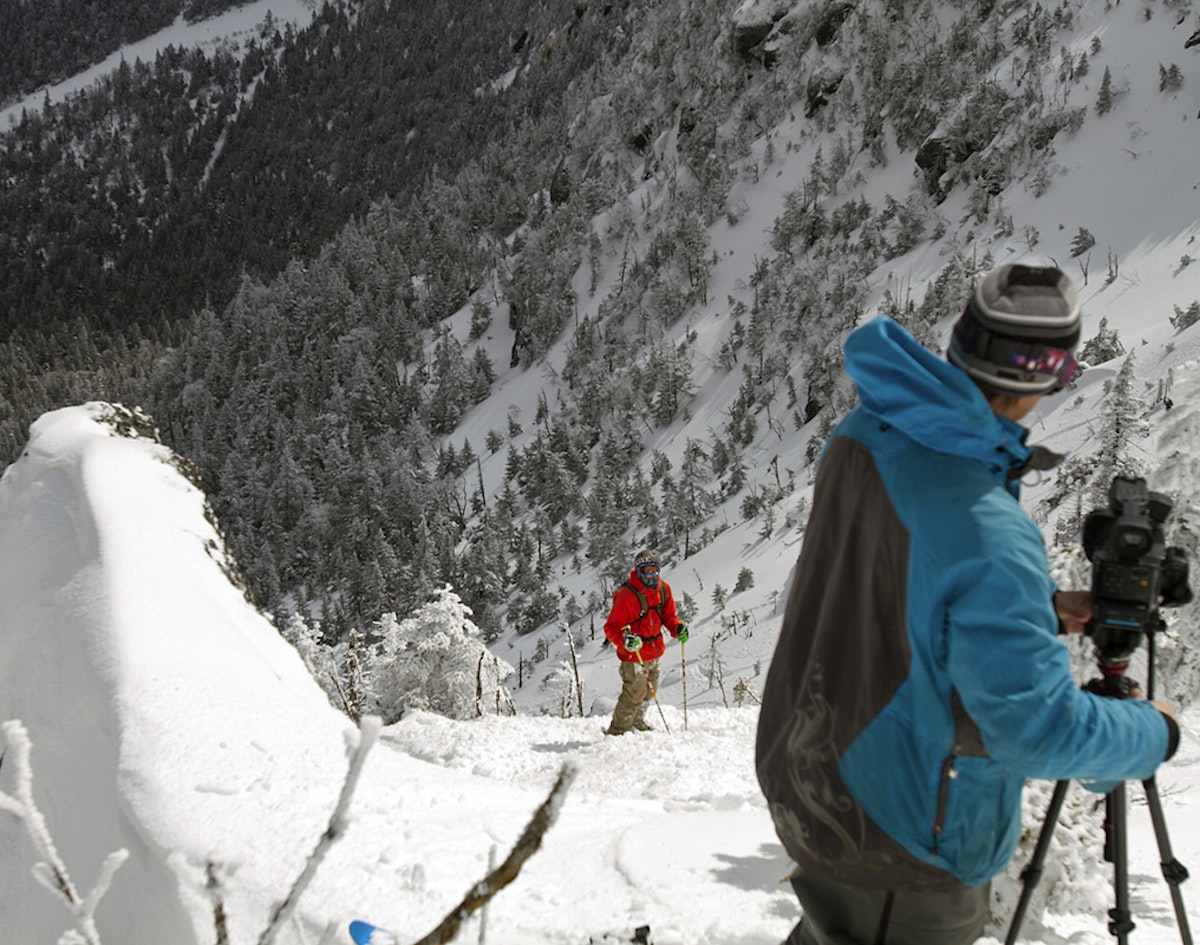
![[GIVEAWAY] Win a Legendary Ski Trip with Icelantic's Road to the Rocks](https://www.datocms-assets.com/163516/1765233064-r2r26_freeskier_leaderboard1.jpg?w=200&h=200&fit=crop)
![[GIVEAWAY] Win a Head-to-Toe Ski Setup from IFSA](https://www.datocms-assets.com/163516/1765920344-ifsa.jpg?w=200&h=200&fit=crop)
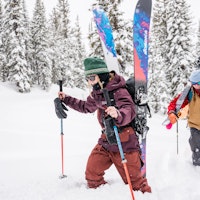
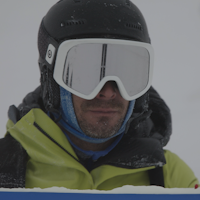
![[GIVEAWAY] Win a Legendary Ski Trip with Icelantic's Road to the Rocks](https://www.datocms-assets.com/163516/1765233064-r2r26_freeskier_leaderboard1.jpg?auto=format&w=400&h=300&fit=crop&crop=faces,entropy)


![[GIVEAWAY] Win a Head-to-Toe Ski Setup from IFSA](https://www.datocms-assets.com/163516/1765920344-ifsa.jpg?auto=format&w=400&h=300&fit=crop&crop=faces,entropy)


